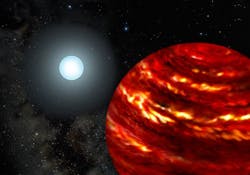NASA eyes space exploration smallsat and on-board instruments to explore atmospheres of gas giant planets
Officials of the National Aeronautics and Space Administration (NASA) Marshall Space Flight Center near Huntsville, Ala., issued a request for information (80MSFC19ST329) on Friday for the Smallsat Exploration of the Exospheres of Nearby Hot Jupiters Orbiting X-ray Bright Stars (SEEJ) Mission Support Capability project.
NASA Marshall researchers are trying to find companies able to build and operate a smallsat bus, on-board scientific instruments, and ground support equipment to explore the exospheres of nearby Hot Jupiters that are orbiting X-ray bright stars.
An exosphere is the outermost regions of a planet's atmosphere. Hot Jupiters are gas giant planets that are so close to their host stars that their orbital periods are shorter than 10 days. Gas giants are planets composed mainly of hydrogen and helium, and contain the same basic elements as a star; Jupiter and Saturn are the gas giants of Earth's solar system. Exoplanets are located outside of Earth's solar system.
To develop a spacecraft and on-board instruments to observe Hot Jupiters outside the solar system, NASA officials say they envision an industry team where the partner will assess options with the mission proposal team.
Related: Space: the next frontier of rad-hard
NASA is trying to evaluate company capabilities that could be used on a small spacecraft like an evolved expendable launch vehicle secondary payload adapter suitable for a future SEEJ mission.
Companies interested should email 10-page .pdf responses no later than 19 April 2019 to NASA's Robyn Crabtree at [email protected].
For questions, concerns, or to get more details of the necessary spacecraft bus, integration, and mission services, contact NASA's Robyn Crabtree by email at [email protected], or by phone at 256-961-7442.
More information is online at https://www.fbo.gov/notices/ecd3a0132511e4db7f1a1e497aeb1b2c.
Ready to make a purchase? Search the Military & Aerospace Electronics Buyer's Guide for companies, new products, press releases, and videos
